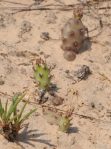
Griffiths, Monatsschrift fur Kakteenkunde 23: 133, 1913
Herbarium; Herbarium; Herbarium (with O. cespitosa); Herbarium; Herbarium (with O. cespitosa); Herbarium (with O. cespitosa); Herbarium; Herbarium
Joe Shaw and Barry Snow
Original Description
What is Opuntia nemoralis?
Opuntia nemoralis is a southern Midwest prickly pear that occurs in saline prairies, sandhills, and shale outcrops in Arkansas, Louisiana, and Texas.
See GenBank locus JQ245720.
Details
Plants may sprawl to 1 m across and reach 30 cm tall, sometimes forming clumps. The cladodes are ovate to obovate and thick, 7-9 cm long and disarticulating. Cladodes may be green or with purple blotches surrounding the areoles. There are 1-2 spines in the distal areoles, perhaps 2-2.5 cm long. Older cladodes are wrinkled.
Flowers are yellow with relatively few tepals. The fruit is about 17 mm thick and 32 mm long, pyriform or obovoid, truncate, and light red. Fruit pulp is slightly reddened.
O. nemoralis is tetraploid.
Other Notes
Plants observed north of Lake Ouachita in Arkansas were glaucous/pruinose, especially in winter. Plants near Longview, Texas, had purple areoles that were striking.
Plants from Hot Spring County, Arkansas, were in xeric, fractured, flaky, acidic shale bedrock along Highway 81 near Interstate 30. A Cladonia sp. (lichen) was abundant. Other habitat-associated plants included Andropogon scoparius, Croton wildenowii, Polygonum tenue, Grindelia lanceolata, and Eriogonum longifolium.
O. nemoralis is uncommonly encountered. This prickly pear has erroneously been conflated with O. humifusa, but it is different from O. humifusa, although it is a member of that clade.
For more information, see:
Majure L.C., Judd W.S., Soltis P.S., and Soltis, D.E. (2017) Taxonomic revision of the Opuntia humifusa complex (Opuntieae: Cactaceae) of the eastern United States, Phytotaxa 290.























